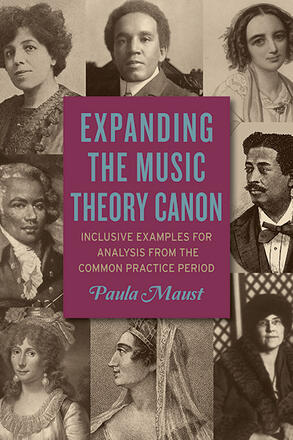
Expanding the Music Theory Canon
Inclusive Examples for Analysis from the Common Practice Period
Alternative formats available from:
The first music theory anthology to provide 255 topically arranged examples by 67 historical women and people of color
Description
Featuring music by sixty-seven historical women and/or people of color, Expanding the Music Theory Canon is designed to supplement any introductory Western classical music theory curriculum. At a time when many academics are focused on increasing diversity and inclusion, this book provides the means to seamlessly incorporate works by underrepresented composers into music theory core courses. The anthology’s 255 musical examples are organized topically and include excerpts as well as nineteen complete pieces for analysis. Each chapter begins with guided analysis questions aimed at students approaching these concepts for the first time. Notably, this anthology provides a biography and image for each composer, which is particularly significant since works by these individuals have rarely been included in previous textbooks or anthologies. A related website, www.expandingthemusictheorycanon.com, provides additional examples and links to recordings when available. All musical examples in the anthology have been classroom-tested with music majors and minors at a major conservatory, at private and public universities, and at community colleges. Detailed tables provide suggestions for using this book in conjunction with the major introductory theory textbooks.
A special set of online exercises has been prepared by the book's author using the Auralia & Musition software programs; you can find further information here: https://www.risingsoftware.com/expanding-the-music-theory-canon.
Additional examples and a blog offering teaching suggestions may be found at: https://www.expandingthemusictheorycanon.com.
Paula Maust is Assistant Professor of Music Theory at the Peabody Institute of the Johns Hopkins University.
Reviews
"Paula Maust's Expanding the Music Theory Canon is an indispensable resource for music theory educators who wish to move beyond the narrow confines of twentieth-century academic music. Now that we music scholars have finally come to the consensus opinion that it was exclusionist to teach only a handful of so-called canonic composers who, in the United States, were of necessity both white and male, we all desperately need resources outlining the rich and varied compositional output of those who identified otherwise. Because sources have been hard to locate and procure, musicians wishing to expand the canon are often left with few good resources to work with. Maust's anthology goes a long way in solving this dilemma. With sections on and examples of the basic topics of common-practice tonality—such as scale types, various meters, melodic embellishments, harmonic syntax, formal structures, and post-tonal topics—Maust's anthology will be invaluable to all who wish to make the music classroom more inclusive of all students, and more welcoming for everyone." — Philip Ewell, Professor of Music Theory at Hunter College, CUNY and author of On Music Theory, and Making Music More Welcoming for Everyone
Praise for Paula Maust’s website, Expanding the Music Theory Canon:
“Congratulations on completing this wonderful project. This is such a significant contribution to the field of music theory.” — Joseph Chi-Sing Siu, University of Maryland Baltimore County
“She’s doing what most of us are talking about and not knowing how to do.” — David Forrest, Texas Tech University and President, Texas Society for Music Theory